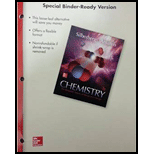
Concept explainers
(a)
Interpretation:
The combined heat of hydration for the ions in
Concept introduction:
The enthalpy is the
The enthalpy change of hydration is the enthalpy change when one mole of the ionic species is dissolved in water to give a solution of infinite dilution. It is represented by
(b)
Interpretation:
The ion that contributes more to the heat change of hydration in part (a) is to be determined. Also the reason for more contribution of the ion is to be given.
Concept introduction:
The enthalpy is the thermodynamic property of the system. It is defined as the sum of internal energy and the product of pressure and volume of the system. It is a state function and is independent of the path followed by the system from initial to the final state. It is an extensive property. The total enthalpy of the system cannot be measured directly so the change in enthalpy
The enthalpy change of hydration is the enthalpy change when one mole of the ionic species is dissolved in water to give a solution of infinite dilution. It is represented by
The degree of hydration depends on the size of the ions. If the size of ion is small it will be easily and more hydrated as compared to the larger ion. So the smaller ion contributes more to the heat change of hydration.
Trending nowThis is a popular solution!

Chapter 13 Solutions
Chemistry: The Molecular Nature of Matter and Change (Looseleaf)